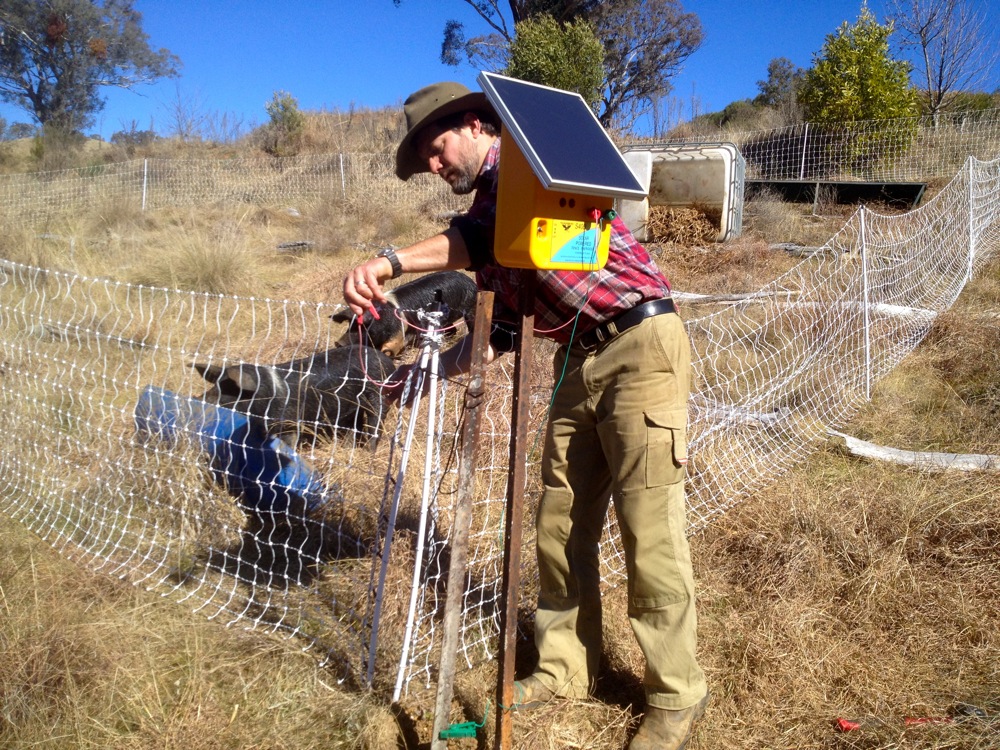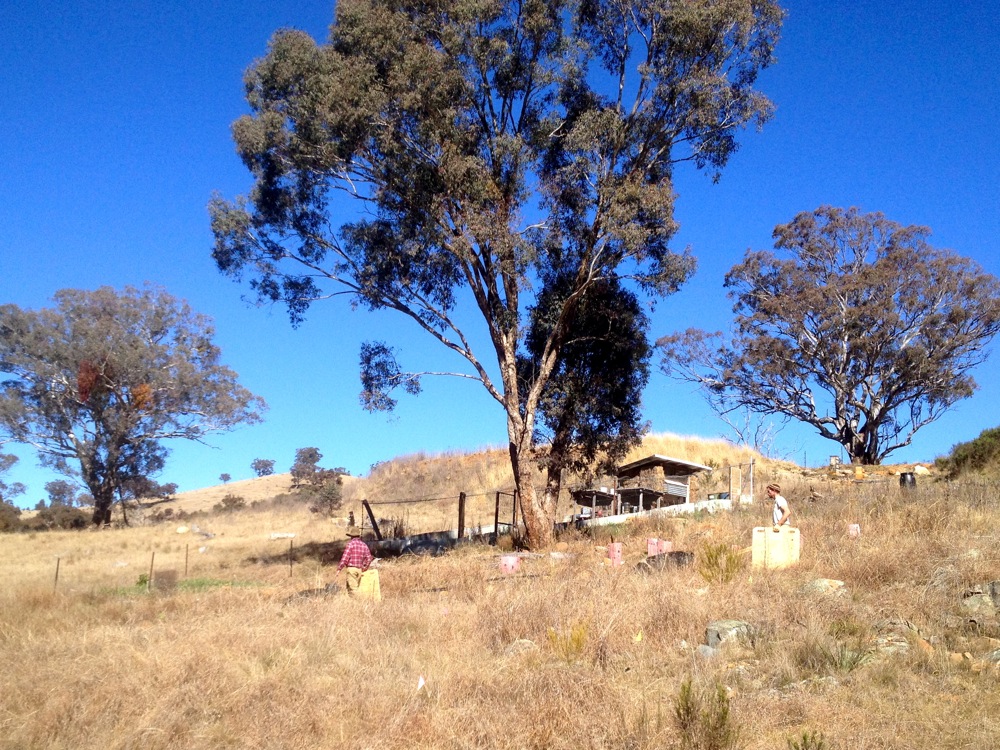 Time to move the pigs. They’ve done a great job tractoring and manuring up in the suntrap, in readiness for groundcover plantings. Now we need their help down below the swale, to help prep ground for the new forest garden.
Time to move the pigs. They’ve done a great job tractoring and manuring up in the suntrap, in readiness for groundcover plantings. Now we need their help down below the swale, to help prep ground for the new forest garden.
Time for the biggest adventure the pigs’ lives on their own trotters – all the way down the hill and around the corner. Will a bucket of feed be enough to entice them to go the right way? What if they make a break for it? Just in case, time to make some pig boards, the pig fancier’s best friend…
We first encountered pig boards at Ormiston Farm, when James and Georgie kindly lent us some pigs last August to help us prep the market garden space. A full grown pig, it must be said, can be a little stubborn when told where to go.
Pig boards protect the pig wrangler from getting their ankles munched by a pissed-off sow, and more often, just provide a clear indication to the pig of where you don’t want them to go. Let’s keep this civil – we’re all friends, after all. Friends in a bacon-loving way, yes, but companions nonetheless.
Now that we’ve got ourselves a couple of pigs (to get a feel for them, while we dream of forested pork action in the future), it’s time for some pig boards of our own. I have no idea how much the red ones cost, or where to get them from, but we do have some spare plywood at the moment…
Nick’s DIY pig boards – 3 handles per board. Each handle hole is made by cutting two big holes with a holesaw, and then cutting out the area in between those two holes with a jigsaw.
This makes for very comfortable handles, which is important if you’re going to hold the darn things for 30 mins or so while maneuvering pigs.
Plus, the cut out plywood circles make great car wheels…
Completed pig boards! And pig-persuaders as well. We’re ready to go…
Which in Stephen’s hands, quickly turned into talk about pig boards and pig swords, with many allusions to valiant knights, going forth (sigh). Let’s go move the pigs, shall we?
And it was all going so very well until…
The piggies discovered a nice wet spot next to their new enclosure. Time for a wallow.
But between the bucket of pig pellets, treats of dried maize on the cob and the pig boards, we got them in…
Electric fence all wired up, and everyone’s happy. Just a note that this premier net fencing has worked out really well for the pigs and chickens wherever we’ve used it on the farm this far.
And the Thunderbird solar fence charger which we bought to cell graze the creekflat has been a great bit of kit to keep our fences nice and zappy, resulting in all animals staying put (except for the odd sheep, but that’s sheep for you).
The pigs are watered from a trough which is gravity fed from the top dam, via a waterpoint just up the hill. We fill the trough up with a hose every couple of days, as there’s no point setting up a float system, as the pigs won’t be in this section for very long.
Once inside the fence, the pigs were delighted with their new piece of pasture – they were rooting through the ground immediately, looking for snacks of roots and worms.
In a week or so, we’ll move them on to the next section, leaving a fair bit of ground disturbance and manure in their wake, ready to plant a nucleus forest of apple trees, which will be passively irrigated by the greywater of the tinyhouse, just above the swale.
While these two half-grown piggies will not, by themselves, revolutionize this ground in terms of tractoring and disturbing the soil (unlike the effect that 10 piggies would have in a similar situation), it’s a great way of incrementally increasing fertility on this section of land and creating happy, contented pastured pigs at the same time.
Can’t. Smile. Busy.
Time for a quick picnic and a spot of pig watching…
Our wessex saddleback pigs came from Morrigan Farm near Mudgee, and they are good natured, healthy and happy pigs who have obviously been rooting up ground from an early age, and are very good at it.
Which will soon be providing us with Milkwood-raised protein and new pork-filled delights (using our Farmstead Meatsmith resources as a guide, among others). We’ll be back for more piglets in the Spring!































Hi
Is this fence from Allsun. I’m looking at the possiblly of getting one. Do you find them easy to use as little old me will need to look after it. Sorry another questions where did you get the solar pack from.
I look you blog.
Sam
No this netting is premier poultrynet: http://www.premier1supplies.com/detail.php?prod_id=24022&cat_id=139 as used at Polyface Farm, but Allsun’s product is excellent also – we got this premier net as part of a group order that Darren Doherty initiated a couple of years back – he now sells it himself http://www.hdshed.com/ but only in group orders, so you need to wait for critical mass before you get your gear.
There are some other aussies selling the premier gear here and there…
Solar pack is the Thunderbird S40B http://www.thunderbird.net.au/solar.htm and we love it!
How do you find the electric netting? I wonder how it copes touching the ground, do you find it shorts out alot? Does it drain the electric fence batteries? I bought some a few years ago, its not as good as I had hoped (it was before they seemed to become more common).
We’ve found it really good! I think the tech is improving all the time perhaps? This is what we use: http://www.premier1supplies.com/detail.php?prod_id=24022&cat_id=139
Hi Kirsten. (Although it’s four years since you wrote this) I’ve looked up that link (Premier Supplies for a moveable fence). The link seems to show that they’re in the United States. Did you happen to find a supplier in Australia? [I’ve already bought one in South Australia (different brand) but need another one, the ‘Premier’ seems to be way cheaper.] With thanks, Rasili (O’Connor)
Don’t worry about that query from me! Just saw your post further down the page (re Premier, etc).
Hi Kirsten From my own experience that fencing is not very good with pigs, to easy too short out and too easy to get tangled in and suffocate/strangle the pig. It won’t keep out feral Boars either. We’ve had growers here caught up in it several times trying to get into our chickens. Luckily no fatalities yet, but some close calls. I know people out at Boroowa who have lost pigs because they get stuck in the netting, the pig then panics and ends up being choked – you’ll need to keep a really close eye on them. It’s like… Read more »
Hi Martyn, cheers for all that info! I’m a bit at a loss to see how, at their current size, they could strangle themselves in something that they cant fit more than their snout thru… but thanks for the tip, i can see how it could be a prob with younger pigs – this fencing isn’t our long-term solution for pigs, it’s a case of using what we’ve got, where/when we’ve got it. I really like the sound of your system! For us, this is perfect for the time/energy inputs we have available right now at this time of year… Read more »
Kirsten,
Have you used this netting for the chooks. I am trying to work out whether it would stop our foxes from getting under or over and into the chooks?
Many thanks
Peter
We’ve used it for chook tractors with the chooks always put away somewhere secure at night, and I know many others that use it similarly… we’ve had no losses to foxes, but I wouldnt say it’s foxproof…
Hi folks. The netting works extremely well with chickens and sheep. Haven’t personally tried it with pigs, but know a farmer who does with great success. But, that’s not my purpose in this reply. This is: Now that you’ve tried the hard way to move pigs, try the easy way. Check out my blog post and scroll down to the brief and poor quality video showing the easy way. http://bc-microfarming.blogspot.com/2011/08/many-things-happening-down-on-farm.html